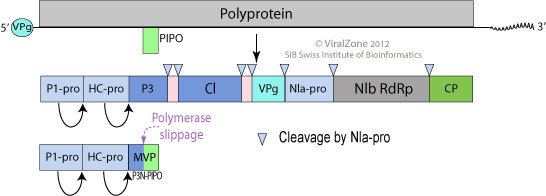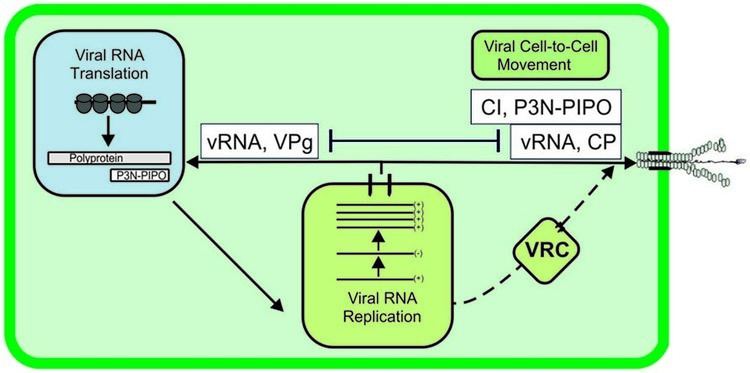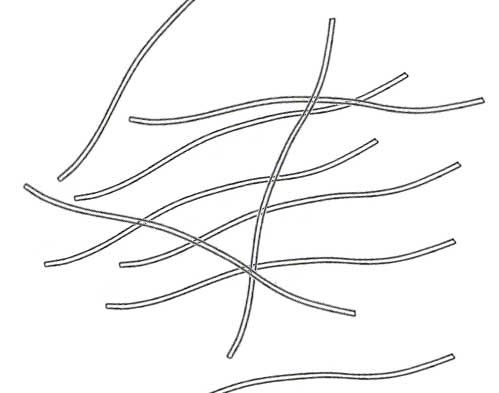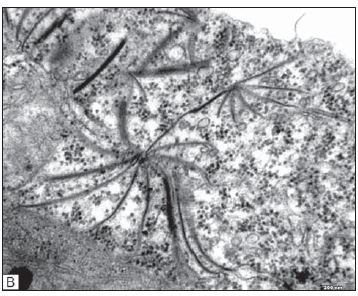Group Group IV ((+)ssRNA) Scientific name Potyvirus Rank Genus | Higher classification Potyviridae | |
 | ||
Lower classifications Potato virus Y, Tobacco etch virus, Papaya ringspot virus, Zucchini yellow mosaic vi, Bean yellow mosaic vi | ||
Vahida eremet plum pox potyvirus is not transmittable
Potyvirus is a genus of viruses, in the family Potyviridae. Plants serve as natural hosts. There are currently 158 species in this genus including the type species Potato virus Y. The genus is named after the type virus (Potato virus Y). Potyviruses account for ~30% of the currently known plant viruses. Like Begomoviruses, members of this genus may cause significant losses in agricultural, pastoral, horticultural and ornamental crops. More than 200 species of aphids spread potyviruses and most are from the subfamily Aphidinae (genera Macrosiphum and Myzus).
Contents
- Vahida eremet plum pox potyvirus is not transmittable
- Medical vocabulary what does potyvirus mean
- Taxonomy
- Evolution
- Virology
- Molecular biology
- Life cycle
- Geographical spread
- References

Medical vocabulary what does potyvirus mean
Taxonomy
Group: ssRNA(+)
Evolution

The potyviruses evolved between 6,600 to 7,250 years ago. They appear to have evolved in southwest Eurasia or north Africa. The estimated mutation rate is about 1.15×10−4 nucleotide substitutions/site/year.
Virology
The virion is non-enveloped with a flexuous and filamentous nucleocapsid, 680 to 900 nanometers (nm) long and is 11–20 nm in diameter. The nucleocapsid contains ~2000 copies of the capsid protein. The symmetry of the nucleocapsid is helical with a pitch of 3.4 nm.

The genome is a linear positive sense ssRNA ranging in size from 9000–12000 bases/nucleotides. Most potyviruses have non-segmented genomes, though a number of species are bipartite. The base composition is: 21–23.51–26% G; 23–30.15–44% A; 14.9–22.41–28% C; 15.6–24.41–30.9% U.

In the species with a single genome, at the 5' end a protein is covalently linked (the Vg protein). It encodes a single open reading frame (ORF) expressed as a 350kDa polyprotein precursor. This is processed into seven smaller proteins: P1, helper component (HC), P3, cylindrical inclusion (CI), nuclear inclusion A (NIa), nuclear inclusion B (NIb), capsid protein (CP) and two small putative proteins known as 6K1 and 6K2. The P3 cistron also encodes a second protein—P3N-PIPO—which is generated by a +2 frameshift.
Molecular biology
Protein P1 (~33 kiloDaltons (kDa) in molecular weight) is a serine protease.

HC (~52 KDa) is a protease that is also involved in aphid transmission. As a protease it cleaves a glycine-glycine dipeptide at its own C terminus. It also interacts with eukaryotic initiation factor 4 (eIF4). It acts as a viral RNA silencing suppressor.
The function of P3 (~41 kDa) is not known. It interacts with large subunit of the ribulose-1,5-bisphosphate carboxylase/oxygenase.
CI (~71 kDa) is an RNA helicase with ATPase activity. It is also involved in membrane attachment.
NIa (~50 kDa) is cleaved into a protease (~27 kDa) and the VPg (~22 kDa) protein.
NIb (~59 kDa) is an RNA-dependent RNA polymerase.

The functions of the 6K1 (~6 kDa) is not known. 6K2 (~6 kDa) protein, having a single trans membrane domain, is accumulating in the host cellular membranes and is thought to play a role in forming the replication vesicles of the virus.

The function of the P3N-PIPO (~25 kDa) is not known but it appears to be essential. It interacts with both the large and small subunits of the ribulose-1,5-bisphosphate carboxylase/oxygenase.
The capsid protein ranges between 30 and 35 kDa in weight.
The VPg protein interacts with eukaryotic initiation factor 4E (eIF4E). This interaction appears to be essential to viral infectivity.
Two proteinases, P1 and the helper component proteinase (HC) catalyse only autoproteolytic reactions at their respective C termini. The remaining cleavage reactions are catalysed by either trans-proteolytic or autoproteolytic mechanisms by the small nuclear inclusion protein (NIa-Pro). This latter protein is an evolutionary homology of the picornavirus 3C proteinase.
Life cycle
Replication may occur in the cytoplasm, nuclei, chloroplasts, Golgi apparatus, cell vacuoles or more rarely in unusual sites.
Potyviruses make proteinacous inclusions in infected plant cells. These may be crystals in either the cytoplasm or in the nucleus, as amorphous X-bodies, membranous bodies, viroplasms or pinwheels. The inclusions may or may not (depending on the species) contain virions. These inclusions can be seen in the light microscope in leaf strips of infected plant tissue stained with Orange-Green (protein stain) but not Azure A (nucleic acid stain). There are four different kinds of Potyvirus inclusions.
Replication follows the positive stranded RNA virus replication model. Positive-stranded RNA virus transcription is the method of transcription. Translation takes place by -1 ribosomal frameshifting. The virus exits the host cell by tubule-guided viral movement. Plants serve as the natural host. The virus is transmitted via a vector (insects). Transmission routes are vector and mechanical.
Geographical spread
Agriculture was introduced into Australia in the 18th century. This introduction also included plant pathogens. Thirty eight potyvirus species have been isolated in Australia. Eighteen potyviruses have been found only in Australia and are presumed to be endemic there. The remaining twenty appear to have been introduced with agriculture.
